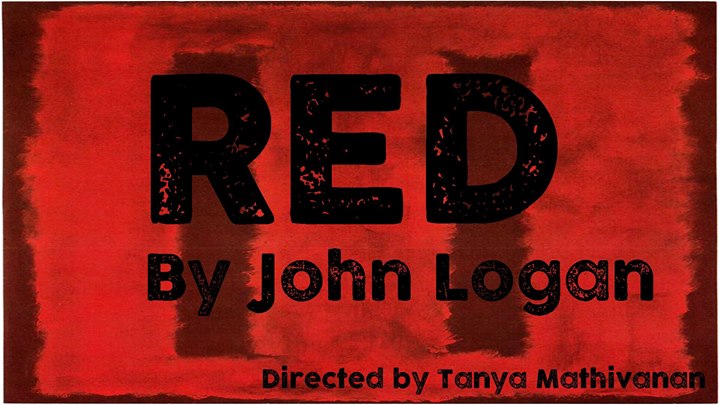“What do you see?” With this opening line begins Aenigma Theatre’s production of the Broadway play, RED.
The question is directed by the infamous painter, Mark Rothko (played by David J Bodor), to his new assistant, Ken (played by Patrick Dodd). Ken being a timid but frank individual replies hesitantly.
“Red.” Both he and Rothko are referring to the Seagram Murals, or at least the working drafts of them. From here, the two characters form an interesting companionship based around a mutual passion for visual art and the constant critique of it.
RED premiered on Monday, July 4th, at the Little Mountain Gallery in East Vancouver. The modest set comprised of a coat rack, a wooden work desk, a record player, and a large vertical wooden beam used as an easel. There was sparse lighting throughout the play but intentionally so as the character of Rothko explains his paintings cannot not live, really “pulse”, in bright environments.
Not only is Rothko extremely conscious of what environment his paintings can reside in, but he is also equally as aggressive about what kind of environment he, himself, can work within. Specific records of a particular genre only are allowed to be played in the art studio and when Rothko finally moves to put paint to brush after hours, even days, of thinking, absolutely no outside input is allowed. Ken learns both lessons the hard way as sudden violent outbursts from the painter shake calms moods into stormy frenzies.
The play fluctuates from sparse dialogue and thoughtful monologues to sudden and enraged, rapid-fire dialogue between the two characters. Additionally, the play is generously peppered with references that assume you have gone to art school or at least a post-secondary institution. Van Gogh, Picasso, Nietzsche, Socrates, are just a few of the many famous names thrown about in casual passing by Ken and Rothko as they dig deeper into each other’s psyche.
However, that is precisely the biggest critique I would have to make of this production. Too often in the play, I experienced moments where I was intrigued by the ideas put forth and duly disappointed at the lack of a follow-through.
To elaborate, I thought the exploration of Ken’s backstory as an orphan intriguing but only explored to the extent that it could help Rothko provoke Ken into anger. Discussion surrounding the efficacy of placing weight behind the use of certain colours, as well as, talk about the value of temporal art as opposed to long standing classics, were just two of the many ideas raised and flown through without maturation.
This is why though I absolutely enjoyed the amount of time I spent in quiet contemplation and research after the end of the production, I could not place a finger on anything the play itself offered as a detailed and insightful takeaway; other than perhaps, do not be a sell out or fool yourself into thinking you aren’t one when you really are.
I assume the lack of the depth was partially due to the actual time restraints of the play, an hour and half run-time, as well as, the need for lots of explanative context in order to fully unpack the terms of each conversation for the general viewer.
I was impressed by the fluidity by which the language used was spoken so with ease and confidence by both actors. In terms of acting, I commend both David (Rothko) and Patrick (Ken) for putting their all into the characters especially so during the scene of the final argument.
***WARNING: SPOILERS AHEAD***
As Ken finally begins to figure Rothko out after two years of shadowing the erratic painter, Ken takes bold steps at not just taking critique but throwing it back. Ken’s emotional outburst lands right at the heart of Rothko’s inner dilemma at the commission he is being given to paint for the Four Seasons Restaurant. So much so, that Rothko ends up calling the Four Seasons and retracting his agreement to paint for them.
This is a play that will confirm and contest your assumptions about contemporary art and the artistic process. It will leave you wondering if the kind of paternal love Rothko has for all his paintings as depicted in the story is a tragic or beautiful thing.
For anyone interested in seeing RED, tickets can be purchased here. Please note that due to the set-up of the stage, latecomers will NOT be allowed entry. The main entry doors leads directly onto the stage and as such, arriving early to the play to get settled into seats cannot be stressed enough.
That is all for now! Until next time, Arts Report listeners!
Written By Christine Kim

